Beef prices are projected to continue increasing as U.S. beef production declines with no signs of a cattle herd rebuild. Additionally, cheap beef may soon become further out of reach…
Federal Reserve: Observations on the Ag Economy- October 2020
On Wednesday, the Federal Reserve Board released its October 2020 Beige Book update, a summary of commentary on current economic conditions by Federal Reserve District. The report included several observations pertaining to the U.S. agricultural economy.
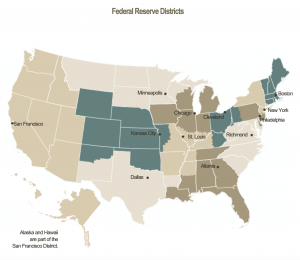
* Sixth District- Atlanta– “Agricultural conditions remained weak. While drought- free conditions prevailed in most parts of the District, some producers reported crop and infrastructure damage caused by Hurricanes Laura and Sally.
The USDA reported that District farmland values were up on a year- over-year basis except in Florida where cropland value was unchanged.
“Cotton, peanut, and rice harvesting progressed, though below the pace of their five-year averages, while soybean harvesting was near its five- year average. The USDA reported that in August, year- over-year prices paid to farmers were up for cotton, rice, soybeans, and milk, but down for corn, cattle, broilers, and eggs. On a month-over-month basis, prices increased for rice, soybeans, and cattle but decreased for corn, cotton, broilers, eggs, and milk.”
* Seventh District- Chicago– “Rising prices for key agricultural commodities and additional government support lifted expectations for farm income for the year.

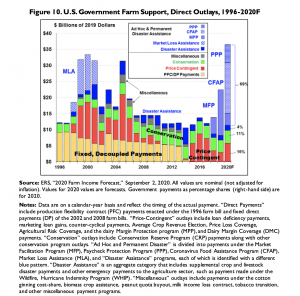
“Corn, soybean, and wheat prices moved higher, reflecting in part lower stocks compared with a year ago. Increases in corn and soybean exports, particularly to China, also supported prices.
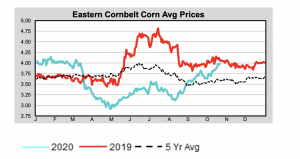
“In addition, a dry August held back expected yields. Dairy prices were higher, supported by increased sales to food service establishments, and strong exports. Hog prices increased while cattle prices decreased.
There were reports that improved income prospects had eased stress on agricultural borrowers somewhat, though concerns remained for next year, when government support was expected to drop substantially.
* Eighth District- St. Louis– “Agriculture conditions have slightly improved. Overall, contacts reported that year-to-date revenue remains steady or slightly up. The agribusiness sector has remained steadier than most, but the effects have been diverse across the industry: Restaurant demand has been collapsing, but grocery spikes have been more than filling the shortfall. Most supply chain bottlenecks were early in the spring and have smoothed out in recent months. Overall, contacts expect business activity for the remainder of 2020 will remain steady or increase slightly.”
* Ninth District- Minneapolis– “District agricultural conditions improved going into the harvest season, however low prices depressed the outlook for farm incomes. Harvests were generally proceeding ahead of schedule in most areas of the District, and the majority of crop acres as of early- October were in good or excellent condition.
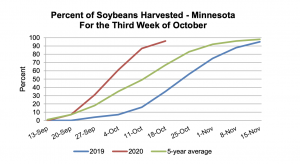
“Despite recent drought conditions in some parts of the District, early estimates called for strong yields of corn and soybeans and record production in some states.”
* Tenth District- Kansas City– “Economic conditions in the Tenth District agricultural sector improved slightly from the previous period despite intensifying drought conditions in some parts of the District. Alongside government payments that were expected to help offset revenue losses, prices for most of the region’s major agricultural commodities increased slightly in late September.
Corn up nearly 30% since August, and the increased optimism is almost as unbelievable as the pessimism that prevailed 3 months earlier. It’s been a volatile year in ag.
— Nathan Kauffman (@N_Kauffman) October 20, 2020
“However, apart from soybean and hog prices, agricultural prices generally remained low. Drought conditions intensified, particularly in western District states.
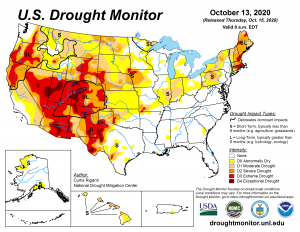
“Through September, the share of corn and soybean acres in poor condition was higher than a year ago and above the national average in all states except Missouri. Extreme drought in portions of Colorado, Wyoming, New Mexico, Oklahoma and Nebraska could further lower crop revenues and reduce income prospects for cow-calf producers impacted by the severe conditions.”
* Eleventh District- Dallas– “Soil moisture conditions deteriorated further across the western part of the district, where drought conditions continued to intensify. Row crop harvesting progressed and yields were quite strong, notably higher than last year for several crops. Grain prices generally improved over the past six weeks and will have reached profitable levels if production is at least average. Drought hampered pasture conditions in parts of the district, which coupled with increased feed costs strained livestock producers. Contacts expressed concern over the La Niña weather pattern that has developed and is likely to persist through the winter, which will bring drier weather and could hinder crop and pasture conditions.”
* Twelfth District- San Francisco– “Conditions in the agriculture sector improved modestly. Most of the grain crops in the Mountain West and the eastern Pacific Northwest have been harvested, with high yield and quality. Yields of grapes, nuts, peaches, and tomatoes in California’s Central Valley also were good. Potato output was not as high as expected, though quality remained high. Domestic sales of peaches, wine grapes, vegetables, oils, seafood, and beef rose on the tailwind of ameliorated supply chain disruptions and reduced costs. Higher output and a recent depreciation in the U.S. dollar contributed to increased international sales of grain, fruit, raisins, and nuts, principally to Asian markets. Growers throughout the District reported the potential risks of new COVID-19 cases among their workforce as well as wildfires, which could harm supply chains and production.”





